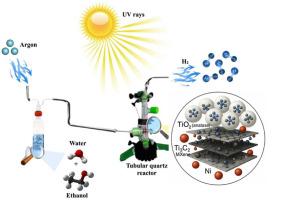ni掺杂TiO2-MXene杂化光催化剂协同增强太阳驱动析氢
IF 8.3
2区 工程技术
Q1 CHEMISTRY, PHYSICAL
引用次数: 0
摘要
开发用于可持续制氢的高效光催化剂是太阳能转换的关键优先事项。在这里,我们提出了一种二氧化钛基光催化剂与镍掺杂剂和Ti3C2Tx MXene共改性,以改善光吸收,电荷分离和界面电荷传输。采用HF腐蚀Ti3AlC2 MAX相、掺杂镍、热煅烧的方法合成了该杂化材料。物理化学表征(XRD, SEM/TEM, XPS, UV-Vis, PL, FTIR, Raman)证实了TiO2, Ni2+物种和部分氧化MXene薄片的成功整合。电化学阻抗谱(EIS)和瞬态光电流响应测量表明,电荷迁移率提高,复合减少。在所测试的样品中,TiO2-2 % ni - 10% MXene复合材料表现出最好的性能,在紫外光下的析氢速率为47.2 mmol h−1 g−1,表观量子产率为5.5%。这种增强的活性是由于Ni掺杂(引入浅阱和促进质子还原)和导电MXene相(促进电荷转移和提供活性位点)的协同作用。该研究为设计高效的二氧化钛基光催化剂提供了一种可扩展的双改性策略,并为太阳能驱动制氢的先进材料的合理开发提供了宝贵的见解。本文章由计算机程序翻译,如有差异,请以英文原文为准。

Synergistic enhancement of solar-driven hydrogen evolution via Ni-doped TiO2–MXene hybrid photocatalyst
Developing high-efficiency photocatalysts for sustainable hydrogen production is a key priority in solar energy conversion. Here, we present a TiO2-based photocatalyst co-modified with nickel dopants and Ti3C2Tx MXene to improve light absorption, charge separation, and interfacial charge transport. The hybrid material was synthesized via HF etching of Ti3AlC2 MAX phase followed by nickel doping and thermal calcination. Physicochemical characterization (XRD, SEM/TEM, XPS, UV–Vis, PL, FTIR, Raman) confirmed successful integration of TiO2, Ni2+ species, and partially oxidized MXene sheets. Electrochemical impedance spectroscopy (EIS) and transient photocurrent response measurements revealed improved charge mobility and reduced recombination. Among the samples tested, the TiO2–2 % Ni–10 % MXene composite showed the best performance, achieving a hydrogen evolution rate of 47.2 mmol h−1 g−1 and an apparent quantum yield of 5.5 % under UV light. This enhanced activity results from the synergistic effects of Ni doping (introducing shallow traps and promoting proton reduction) and the conductive MXene phase (facilitating charge transfer and providing active sites). The study offers a scalable dual-modification strategy for designing efficient TiO2-based photocatalysts and contributes valuable insights into the rational development of advanced materials for solar-driven hydrogen generation.
求助全文
通过发布文献求助,成功后即可免费获取论文全文。
去求助
来源期刊

International Journal of Hydrogen Energy
工程技术-环境科学
CiteScore
13.50
自引率
25.00%
发文量
3502
审稿时长
60 days
期刊介绍:
The objective of the International Journal of Hydrogen Energy is to facilitate the exchange of new ideas, technological advancements, and research findings in the field of Hydrogen Energy among scientists and engineers worldwide. This journal showcases original research, both analytical and experimental, covering various aspects of Hydrogen Energy. These include production, storage, transmission, utilization, enabling technologies, environmental impact, economic considerations, and global perspectives on hydrogen and its carriers such as NH3, CH4, alcohols, etc.
The utilization aspect encompasses various methods such as thermochemical (combustion), photochemical, electrochemical (fuel cells), and nuclear conversion of hydrogen, hydrogen isotopes, and hydrogen carriers into thermal, mechanical, and electrical energies. The applications of these energies can be found in transportation (including aerospace), industrial, commercial, and residential sectors.
 求助内容:
求助内容: 应助结果提醒方式:
应助结果提醒方式:


